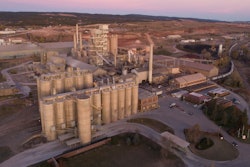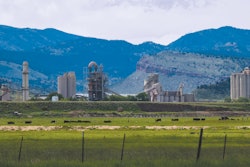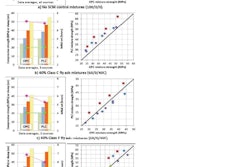
As described on its website, “Caltrans manages more than 50,000 miles of California’s highway and freeway lanes.” After the approval in the fall of 2021, the hired contractors working the state’s road construction, maintenance, and infrastructure projects have the option of using a portland limestone cement (PLC) in the concrete. Caltrans Director, Toks Omishakin is quoted in the announcement calling the decision “a big step in supporting California’s efforts to achieve carbon neutrality.”
California is the 38th state to approve of the use of PLC with Nevada and Arizona subsequently approving. This is only the first step in reaching the global effort of reducing the area's cement production's and concrete construction’s carbon dioxide emissions. Reports state that the use of a portland limestone cement can reduce 10% of the CO2 emissions within the production of cement, annually; with Caltrans reported using 325,000 tons of cement in 2017 to upgrade the state’s highway system, this switch can reduce emissions by 28,000 tons a year.
For context, that’s a reduction of 28,000 tons of CO2 a year from eight cement plants.
The California Nevada Cement Association (CNCA) announced its roadmap regarding carbon neutrality in March 2021. After a three-year-long study at Oregon State University to prove a PLC can perform equal to or better than ordinary portland cement, the Caltrans approval is only the first of the many levers to pull in our country’s journey to addressing climate change.
Ordinary cement starts out by heating limestone up to 2,820 degrees F which creates clinker – a major source of the amount of CO2 emissions in the production. PLC is a blended cement containing less clinker and more limestone (from 5% to 15%) content.
The implementation of PLC is the first lever pulled in the CNCA’s roadmap. “It's a first and easiest first step,” says Tom Tietz, executive director of the CNCA. “We're seeing a growth in that product’s acceptance in the market.” CNCA represents all the cement producers in California and Nevada for regulatory and legislative issues. They also provide education on the use of cement and concrete materials.
He explains the roadmap with three pathways and nine levers with short-, mid-, and long-term goals. The acceptance of PLC in California is one of the first to be met. However, “all nine of the levers need to work in order for this to happen,” he says.
These levers include:
- Portland Limestone Cement
- Carbon Capture Use & Storage
- Alternate Raw Materials
- Alternative Cements & Clinkers
- Natural Gas
- Waste-Derived Fuels
- Biomass-Derived Fuels
- Waste Heat Recovery
- On-Site Renewables
Carbon Capture, Utilization, and Storage
After the acceptance of PLC, the second goal for the CNCA is also one of the longer-term solutions: the integration of carbon capture, utilization, and storage technologies at the cement plants. Tietz sees this as the biggest lever to pull but a vital destination of the roadmap. “It’s absolutely essential that [carbon capture] gets utilized,” he says. “What's interesting to me is that there's about a half dozen bills in the California legislature right now, including one that's specific to the California cement industry to work on a pilot project for carbon capture out of cement plants.” He explains that there are two companies in the state that are already looking at setting up pilot versions of technologies that would also use some level of carbon capture.
The difficulty, however, is scaling these to be fully effective, he says. “That is where the entire industry is still obviously on the learning curve.”
But that learning curve is turning for the better as these pilot programs aren’t alone.
In July 20219, LafargeHolcim – in a partnership with Inventys and Total—launched a four-year-long carbon capture project in Canada, called CO2MENT with the objective to “build the world’s first full-cycle solution to capture and reuse CO2 from a cement plant while also reducing greenhouse gas emissions.” As described in the announcement, this project looks to 1) purify the cement flue gas, 2) focus on the separation of CO2 from the flue gas, and 3) prepare the CO2 for reuse such as the injection into concrete.
In November 2021, the U.S. Department of Energy awarded a grant to CEMEX to develop carbon capture technology at the Balcones cement plant in Texas. According to the announcement, CEMEX partnered with Membrane Technology & Research Inc. to conduct an 18-month study and explore the potential CO2 emission reduction from installing membrane technology in the plant’s production process. According to MTR, the membrane will act as a semi-permeable barrier through which CO2 can pass, facilitating carbon capture at a minimal adoption cost.
In March 2022, it was announced that a cement plant in Japan will begin a 9-month long testing program a carbon capture technology built by Mitsubishi Heavy Industries Engineering Ltd. Flue gas from cement kiln would be introduced to the mobile unit for the demonstration test.
Alternative Fuels
The kilns at cement plants traditionally burn coal and petcoke. Another lever of the CNCA roadmap and mid-term goal is the transition to an alternative fuel. Tietz sees opportunities for all kinds of materials to be used in cement plants, such as biomass, engineered municipal waste, or recycled carpet for example. “There are almost countless ways that these waste products that go to landfill now can be utilized as fuels in cement plants. We see this happening all around the world,” says Tietz. Other alternative fuel options already being utilized include natural gas, pistachio shells, and tire-derived fuel at several California plants.
Likewise, a CEMEX-run plant in Victorville, California, is burning a mixture of tires, wood chips, and a waste such as fabric and plastic.
The California legislative bill SB-596 addresses this (approved by the governor and filed with the secretary of state Sept. 2021). The bill gives a July 1, 2023 deadline for the California cement sector to come up with a plan. Quote: “this bill would require the state board, by July 1, 2023, to develop a comprehensive strategy for the state’s cement sector to achieve net-zero emissions of greenhouse gases associated with cement used within the state as soon as possible, but no later than December 31, 2045.”
“We see countries averaging the usage of more than 60% alternative fuels in Europe, plants that are 100% alternative fuels that are no longer using coal or fossil fuels—that's where we want to go,” says Tietz. However, he says that the average is around 10% and permitting and regulatory barriers are making the transition difficult. “We want alternative fuels to become the default fuel. So, that will be a long-term effort, but it's a big priority for us to get started this year,” he says.
Being more familiar with and using PLC in concrete can be the first lever any concrete contractor can do to participate in the reducing CO2 emissions in the cement and concrete construction industry. The CNCA are working with policymakers and entities like the Carbon Leadership Forum, but they’re also having conversations with architects and engineers striving to reduce embodied carbon every week. Anyone concerned about the amount of and interested in reducing the embodied carbon in the built environment should have these conversations as well.
As vital of a first step this may be Tietz says it will also be extraordinarily difficult and time is ticking. “Every lever in our carbon neutrality plan is designed to accelerate acceptance of carbon capture, alternative fuels, and alternative cement materials. These things have to move in a much quicker way than they have historically. So, that's why we are putting all of our effort towards this.”
The Caltrans approval of PLC is a major step for the state of California, but it’s already been approved nationally by major institutions like the FAA and ACI— there’s even a Department of Defense specification. The CNCA is now aiming at getting more and more people comfortable with the actions they can take to reduce embodied carbon. “For us, that’s 10% on the way to 100%,” says Tietz. “It’s one step at a time.”



















